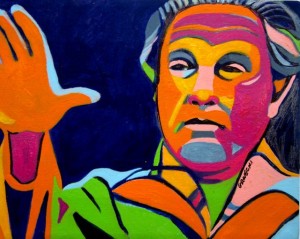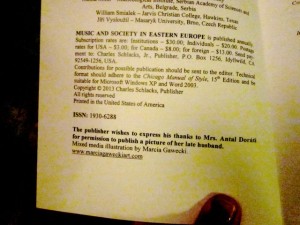By Marcia E. Gawecki
Sometimes, you just have to make things pretty.
My friend, Charles Schlacks, was lamenting one day that he published these well-written art and music journals, but no one was buying them.
“I could retire, if I could sell enough subscriptions,” Charles said, now 83.
I looked at him. He was a publisher his entire life. All the printing equipment was housed in his garage in Idyllwild. Every month, he’d work with editors from all over the world to compile the articles. Then he’d edit, print and send them out to libraries.
The best part is that these editors would sen the articles to him for free.
“There’s a saying in academia, ‘Publish or perish,'” he said.
So if the writing wasn’t bad, it had to be the covers.
“Let’s take a look at your journals,” I said.
He agreed to bring a handful to me the next morning. The covers caught me by surprise. They were printed in bright colors, including reds, yellows and oranges, but with only text. There was no illustrations — no photos, no drawings, no paintings.
Furthermore, the title of his journal was called, “Music and Society in Eastern Europe.”
It reminded me of a college text book.
Here had worked tirelessly to develop music and culture. And even got professors to write articles for free, but no one was reading them because frankly, the covers were boring.
“Maybe I could illustrate your next cover,” I suggested.
Knowing Charles, he wouldn’t want to pay much for it. Normally, a book cover illustration would be at least $100, but since I’ve never illustrated an international journal before, I wasn’t going to quibble.
We agreed on $20 because that’s what I owed him for driving me to Victorville. (That’s another story.) Anyway, he gave me one month to create an illustration of composer Antal Dorati.
He gave me a black-and-white photo from the internet of Dorati with his hand up.
“It has to be a vertical illustration,” he warned.
“Can we drop the hand and just do Dorati’s face?” I asked.
“He’s a composer, so we need the hand,” Charles said.
Over the next several weeks, I worked on Dorati’s image a few hours at a time. I checked out his credentials online. I found out that he was a Hungarian conductor who later became an American citizen.
Doráti became well known for his recordings of Tchaikovsky’s music. He was the first conductor to record all three of Tchaikovsky’s ballets – Swan Lake, The Sleeping Beauty and The Nutcracker. The albums were recorded in mono in 1954, for Mercury Records, with the Minneapolis Symphony Orchestra, as part of their famous “Living Presence” series.
The research inspired me to make a better painting.
Then one day, a photographer friend came into the Acorn Gallery where I work. She was interested in the portrait, but was appalled that I was painting it “as is.”
“You can’t just copy the photograph,” she said. “You have to change something! Turn his head or move his hand. It can’t be exactly like the photograph.”
But I didn’t want to change it. Dorati was a conductor who wouldn’t be turning his head while he was conducting! And to move the hand seemed equally as ridiculous.
I assumed that adding bright colors and sharp lines of my modern, expressionistic style would be enough of a change from the photograph.
“What do other people do when they want to paint someone famous?” I asked.
“They get permission from the relatives,” she said.
So I spoke with Charles the next night about getting permission to use Dorati’s image. I warned him that the family may refuse, or worse yet, ask for money.
“If it’s going to be a problem, then let’s just forget it!” he said, waving his hand.
“Oh no!” I exclaimed. “I’ve invested about 15 hours in this painting already, and I don’t want to give it up!”
So I got the contact information from Dorati’s official web site, and sent it to Charles.
A few days later, Charles emailed me back and said that he had gotten permission from Dorati’s widow in Switzerland.
I was impressed.
Now, my $20 portrait of Dorati had taken on a new importance. His widow was waiting on the image, so it had to be good!
I struggled. I got the eyes right, but the colors wouldn’t gel. For weeks, Dorati had a green shadow on the side of his face that looked garrish, alien, and not becoming to a conductor. But no other colors worked.
In the end, I ran out of time. I didn’t like the green, so I opted for bright pink. I was franticly finishing the painting on my washing machine in the kitchen. I was waiting for the paint to dry so I could take a picture, while cats cried for food under my feet.
“I wonder if all artists live like this!” I shouted, as my cats ran for cover.
“Dorati’s widow isn’t going to like the bright pink,” the voice in my head said.
“But the green looked worse,” I countered.
“You need more time to make the image look dignified,” the voice suggested.
By this point, I had put more than 25 hours into the $20 painting. But I was also keenly aware that maybe some people in Europe would see the illustration, and want to hire me to paint their friends. I fretted, and thought of asking Charles for one more day to finish it.
But his recent email demanded the JPEG as soon as possible. We were out of time! He had to get to the printers!
So conductor Antal Dorati had a bright pink face on the cover of “Music and Society in Eastern Europe,” Volume 8. Whether Dorati’s widow approved, I’d rather not know.
When I saw the cover tonight, I was just happy to be done with it. It wasn’t perfect, but it was definitely bright. Dorati was painted in passionate pink. Would it be enough for someone in Eastern Europe to pick up, read and subscribe for $20?
Alas, $20 seems to be the magic number!
Copyright Marcia Gawecki Art. All rights reserved.


